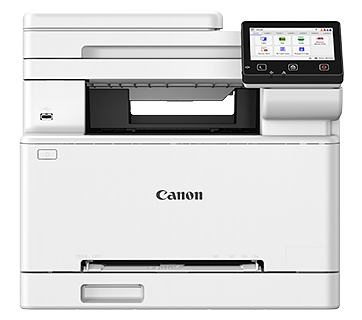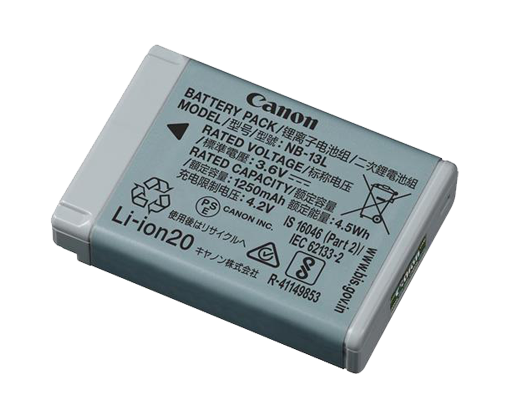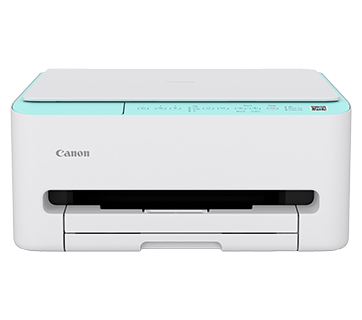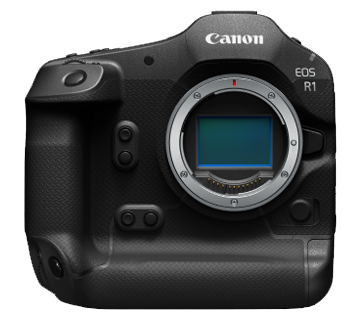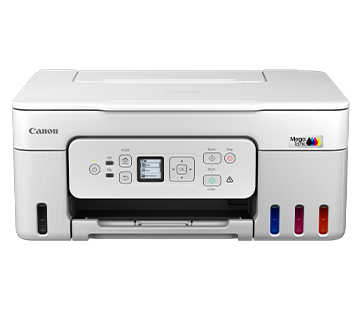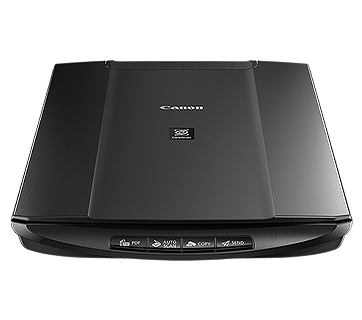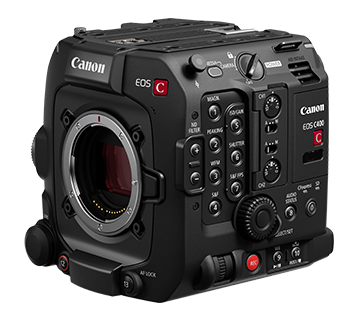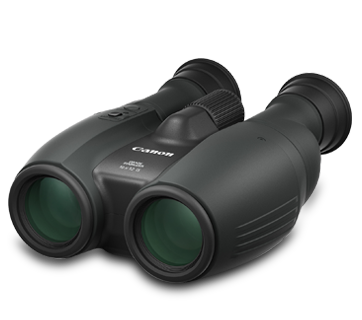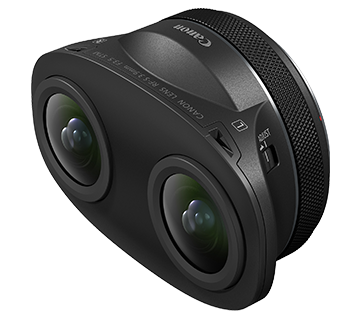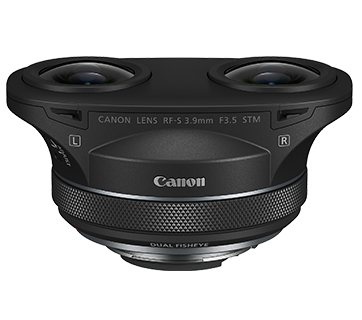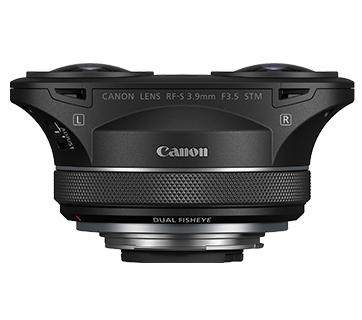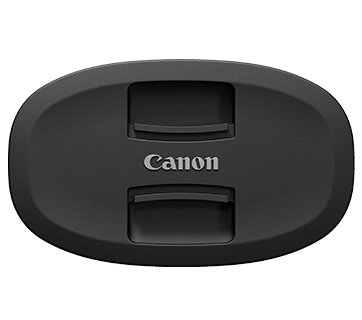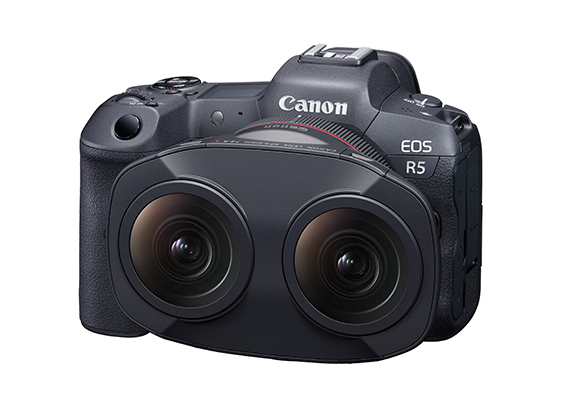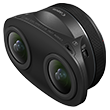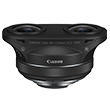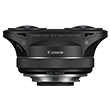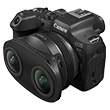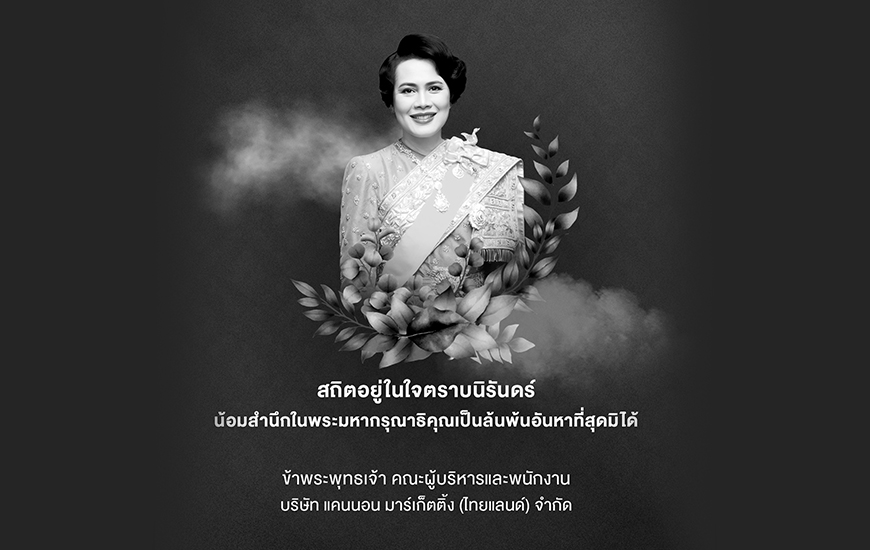RF-S3.9mm f/3.5 STM Dual Fisheye
RF-S3.9mm f/3.5 STM Dual Fisheye
เลนส์ฟิชอายคู่ RF-S3.9mm f/3.5 STM Dual Fisheye มีน้ำหนักเบาพร้อมฟังก์ชันออโต้โฟกัส สามารถจับภาพ 3 มิติ (3D) ด้วยมุมมองที่กว้างถึง 1440 ได้โดยใช้พารัลแลกซ์ของเลนส์ฟิชอายทั้งข้างซ้ายและขวา การออกแบบนี้ช่วยให้เซนเซอร์ตัวเดียวรับแสงได้จากเลนส์ทั้งสอง ทำให้ง่ายต่อการบันทึกเนื้อหาเสมือนจริง ( VR) ด้วยกล้องเพียงตัวเดียว
คุณสมบัติเด่น
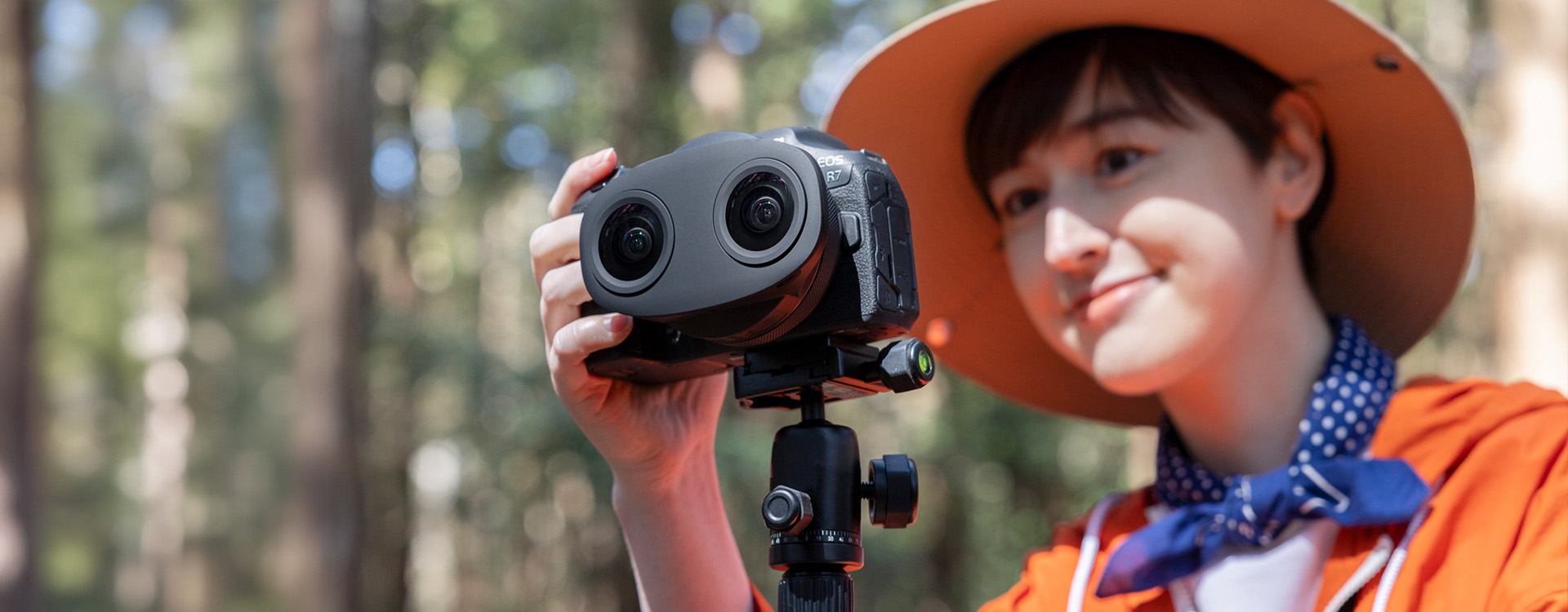
สเต็ปปิ้งมอเตอร์ (STM)
เลนส์ RF-S3.9mm f/3.5 STM Dual Fisheye มาพร้อมกับ สเต็ปปิ้งมอเตอร์แบบเกียร์ (STM) กลไกนี้ควบคุมการเคลื่อนไหวของเลนส์ซ้ายและขวาพร้อมกัน
ระบบออโต้ไฟกัส (AF)ใช้งานง่ายเหมือนกับการใช้เลนส์ RF ทั่วไป โดยมีไมโครโปรเซสเซอร์ขั้นสูงเพิ่มประสิทธิภาพการควบคุมตัวขับเลนส์ให้ตรงกับอัลกอริธึม AF ของกล้องเพื่อการโฟกัสอัตโนมัติที่รวดเร็วและแม่นยำ
ไดอะแฟรมระบบแม่เหล็กไฟฟ้า (EMD) แบบเลนส์คู่
เลนส์ฟิชอายคู่ทั้งซ้ายและขวาของ RF-S3.9mm f/3.5 STM Dual Fisheye มีกลไกไดอะแฟรมระบบแม่เหล็กไฟฟ้า (EMD) ที่ควบคุมการเปิดรับแสงด้วยระบบอิเล็กทรอนิกส์
รูรับแสงกว้างของเลนส์ฟิชอายคู่ RF-S3.9mm f/3.5 STM Dual Fisheye ให้ประสิทธิภาพที่ยอดเยี่ยมแม้ในสภาพรอบข้างที่มีแสงน้อย
รองรับฟิลเตอร์ได้สองประเภท
RF-S3.9mm f/3.5 STM Dual Fisheye มีตัวยึดฟิลเตอร์ด้านหลังที่สามารถยึดได้ทั้งฟิลเตอร์เจลาตินหรือฟิลเตอร์แบบสกรู (30.5 มม.)
การใช้ฟิลเตอร์ตัดแสงแบบใช้มอเตอร์ (ND) จะช่วยให้สามารถถ่ายภาพด้วยรูรับแสงที่กว้างขึ้นได้ แม้ว่าจะถ่ายภาพในช่วงกลางแจ้งในระหว่างวันก็ตาม.
เทคโนโลยีการเคลือบเลนส์แบบ ASC
การเคลือบเลนส์ด้วย (ASC) เป็นเทคโนโลยีการเคลือบที่ให้คุณสมบัติการป้องกันแสงสะท้อนได้ดีกว่าการเคลือบด้วยไอแบบดั้งเดิม
แม้ว่าจะใช้เลนส์ที่มีรูรับแสงกว้าง แต่การเคลือบแบบ ASC บนกระจกโค้งจะช่วยลดแสงแฟลร์และภาพซ้อนของเลนส์ได้เป็นอย่างดี
การปรับโฟกัส
เลนส์ RF-S3.9mm f/3.5 STM Dual Fisheye มาพร้อมกับตัวขับที่สามารถขับเคลื่อนเฉพาะเลนส์ด้านขวาได้อย่างอิสระ
ช่วยให้คุณปรับโฟกัสสัมพัทธ์ของเลนส์ทั้งซ้ายและขวาได้โดยใช้สวิตช์โหมดปรับความแตกต่างของโฟกัสซ้ายและขวาและวงแหวนโฟกัส/วงแหวนควบคุม
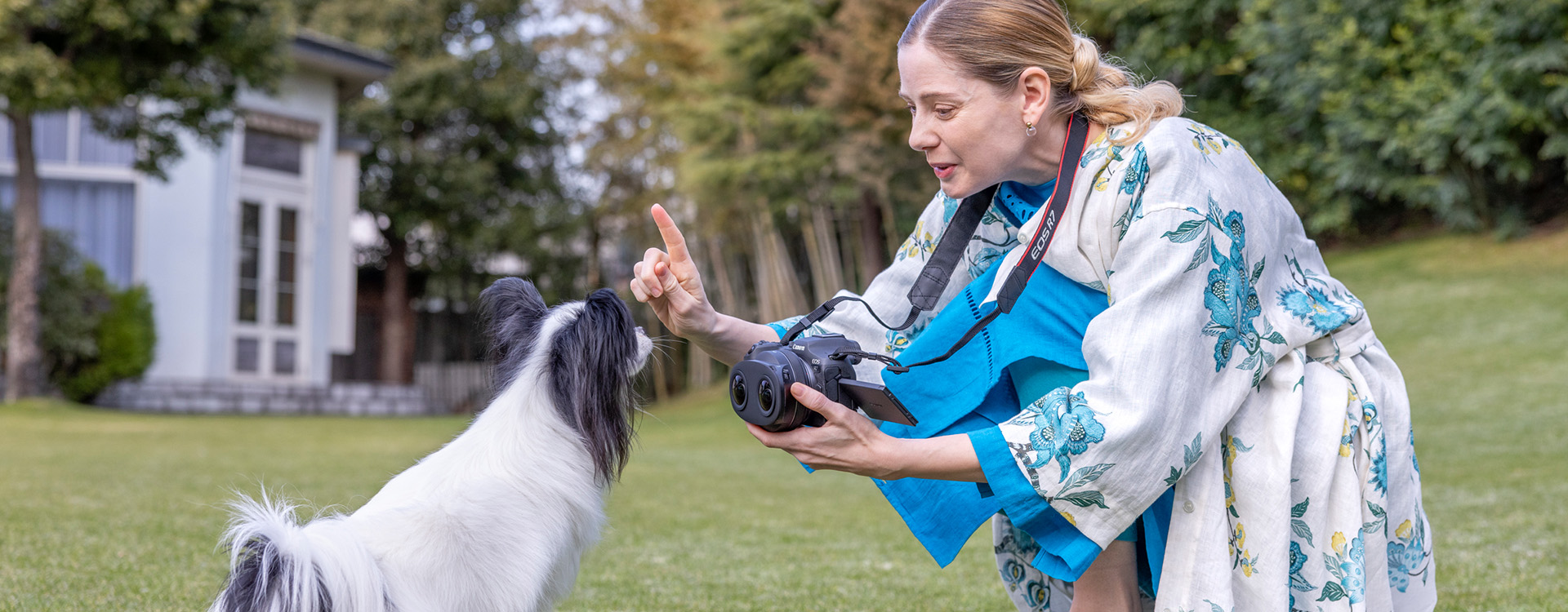
วิธีการทำงานของการถ่ายภาพเสมือนจริง
เลนส์ฟิชอาย 2 ตัว
การบันทึกแบบพารัลแลกซ์โดยใช้เลนส์ฟิชอายสองข้างบนเซนเซอร์ตัวเดียว
การแปลงภาพ
ใช้ซอฟต์แวร์ทำหน้าที่แปลงการบันทึกไปเป็นการฉายภาพแบบ equirectangular ซึ่งเป็นรูปแบบมาตรฐานสำหรับภาพเสมือนจริง (VR)
การฉายภาพไปยัง HMD
การบันทึกที่ผ่านการครอปตัดและแปลงแล้วจะถูกฉายลงบนจอแสดงผลแบบสวมศีรษะ (HMD) เพื่อจำลองการมองเห็นของมนุษย์
ภาพสมจริงแบบ 3 มิติ
การบันทึกจะแสดงเป็นแบบ 3 มิติ (3D) เมื่อดูด้วยตาซ้ายและขวาแยกกันเนื่องจากปรากฏการณ์พารัลแลกซ์
กลไกการบันทึกภาพเสมือนจริง

การบันทึกด้วยเซนเซอร์ตัวเดียว
หากคุณติดเลนส์ RF-S3.9mm f/3.5 STM Dual Fisheye เข้ากับกล้องมิเรอร์เลส EOS R7 คุณสามารถใช้ประโยชน์จากฟังก์ชันการบันทึกของกล้องและสร้างฟุตเทจ VR ระดับ 4K ที่มุมมอง 1440 ด้วยกล้องและเซนเซอร์เพียงอย่างละตัวเท่านั้น
ไม่จำเป็นต้องมีกล้องสองตัว
การบันทึกเนื้อหา VR แบบดั้งเดิมจำเป็นต้องวางกล้องสองตัวให้อยู่ในแนวเดียวกันและซิงโครไนซ์ตำแหน่ง และจำเป็นต้องมีขั้นตอนอื่นๆ เพิ่มเติม เช่น การจับคู่สีและกระบวนการรวมภาพหลาย ๆ ภาพเข้าด้วยกัน แต่ความยุ่งยากเหล่านี้จะหมดเมื่อใช้เลนส์ RF-S3.9mm f/3.5 STM Dual Fisheye ร่วมกับกล้อง EOS R7 ที่มีเซนเซอร์เพียงตัวเดียว
ขั้นตอนการผลิตภาพที่มีประสิทธิภาพมากขึ้น
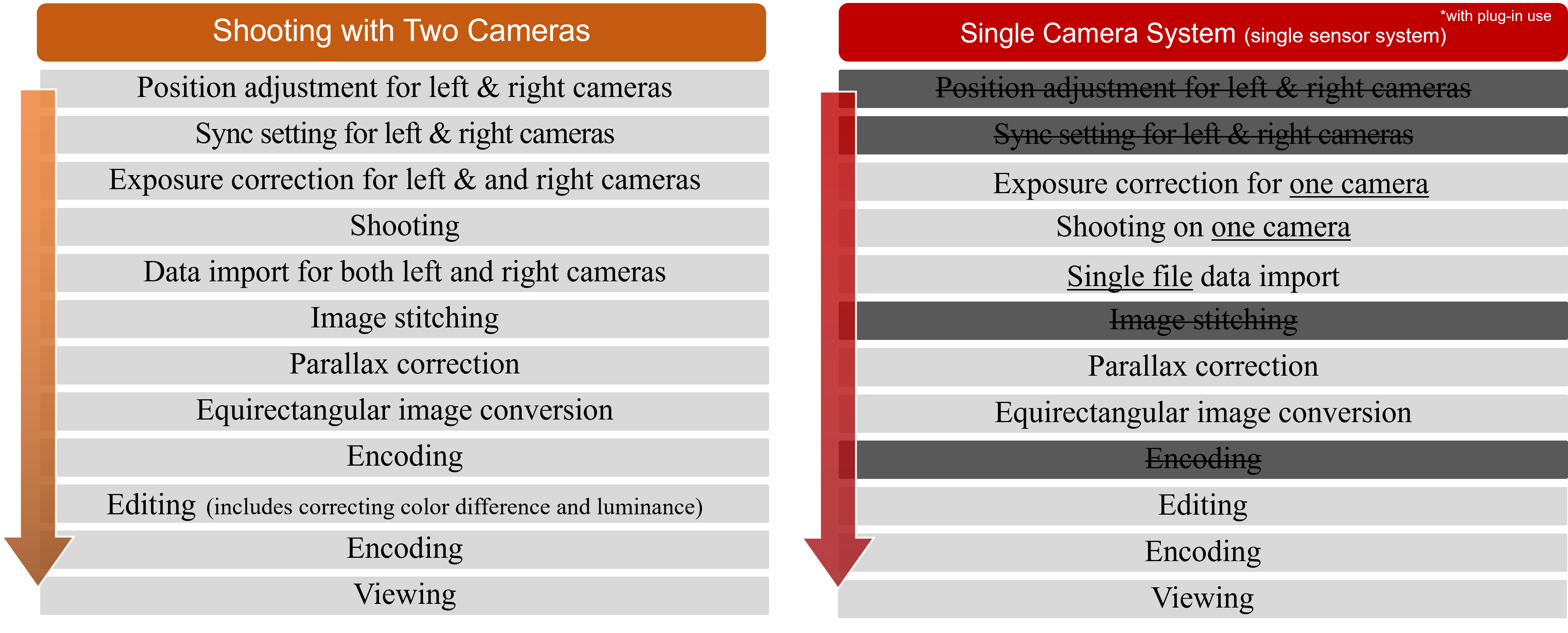
เลนส์ฟิชอายคู่ RF-S3.9mm f/3.5 STM Dual Fisheye รองรับการบันทึกด้วยกล้องตัวเดียวที่มีเซนเซอร์ภาพ CMOS เพียงหนึ่งตัว ลดขั้นตอนหลักบางอย่างที่ต้องดำเนินการเมื่อเป็นการใช้ระบบกล้อง 2 ตัว แบบทั่วไป เช่น การจัดแนวตำแหน่งและการซิงโครไนซ์การตั้งค่าของกล้องซ้ายและขวาก่อนถ่ายภาพ หรือความจำเป็นในการเชื่อมต่อภาพในขั้นตอนหลังการผลิตภาพ
การเล่าเรื่อง
เสมือนจริง
สร้างความแตกต่างให้กับเรื่องราวของคุณ
การทำงานร่วมกันของซอฟต์แวร์สำหรับขั้นตอนการทำงานหลังการผลิต
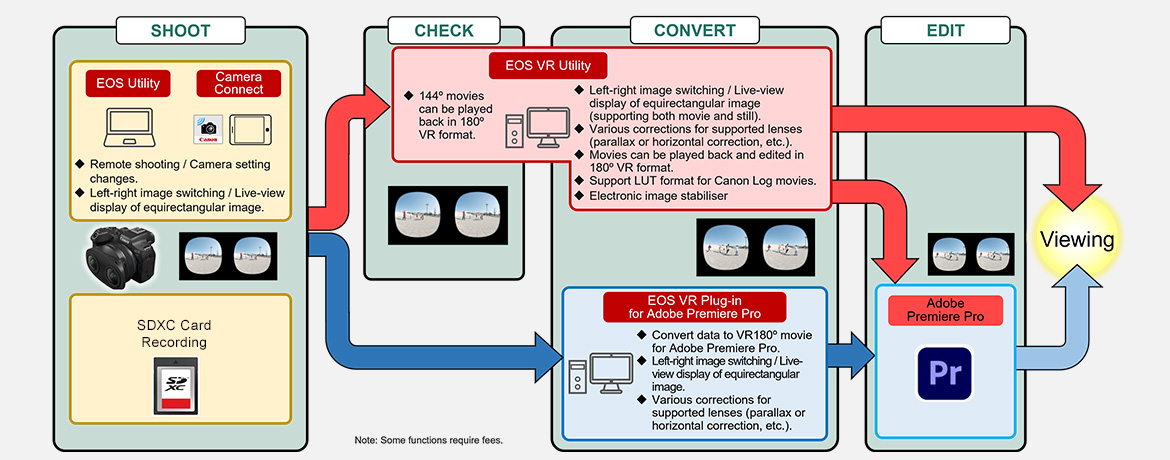
ซอฟต์แวร์ที่สนับสนุนทำให้ขั้นตอนการทำงานหลังการผลิตมีประสิทธิภาพและง่ายขึ้น
ซอฟต์แวร์ EOS VR Utility*
- แอปพลิเคชันซอฟต์แวร์คอมพิวเตอร์ที่ช่วยให้ผู้ใช้สามารถแปลงภาพไปเป็นการฉายภาพแบบ equirectangular (รูปแบบภาพ VR มาตรฐาน) และทำการแก้ไขบนภาพเหล่านั้นได้สะดวก
- รองรับการสลับระหว่างภาพถ่าย / ภาพฟุตเทจ ที่ถ่ายด้วยเลนส์ซ้ายและขวา นอกจากนี้ยังรองรับการสลับระหว่างการแสดงผลจากเลนส์ฟิชอายทรงกลมและแบบ equirectangular
- รองรับการทำภาพให้ตรง / การแก้พารัลแลกซ์ สำหรับเลนส์ที่ใช้ร่วมกันได้
- รองรับการเล่นและการตัดภาพเบื้องต้นบนจอคอมพิวเตอร์สำหรับภาพ VR มุมกว้าง 1800
- วิดีโอที่บันทึกใน 8K สามารถแปลงและบันทึกไปเป็นขนาด ข้อมูลจำเพาะของไฟล์ หรือรูปแบบต่างๆ
- สามารถใช้ไฟล์ LUT (Lookup Table) กับวิดีโอที่บันทึกในโหมด Log ของแคนนอน
- รองรับการส่งออกไปเป็นรูปแบบไฟล์ DPX (Digital Picture Exchange) และ Apple ProRes สำหรับการตัดต่อภาพบนเครื่องคอมพิวเตอร์ที่เรียกว่าระบบ NLE (Non-Linear Editing)
ซอฟต์แวร์ EOS VR Plugin * สำหรับโปรแกรมตัดต่อวิดีโอ Adobe Premiere Pro
- ซอฟต์แวร์ปลั๊กอินบนคอมพิวเตอร์สำหรับผู้ผลิตวิดีโอที่ใช้โปรแกรม Adobe Premiere Pro ในการตัดต่อวิดีโอ
- รองรับการสลับภาพซ้ายและขวาและแปลงภาพเป็นการฉายภาพแบบ equirectangular (รูปแบบภาพ VR มาตรฐาน)
- รองรับการทำภาพให้ตรง / การแก้พารัลแลกซ์ สำหรับเลนส์ที่ใช้ร่วมกันได้
*มีค่าธรรมเนียมการสมัครสมาชิกและ/หรือการชำระเงินสำหรับฟังก์ชันการทำงานเต็มรูปแบบ (การแปลงฟุตเทจที่ยาว 2 นาที ขึ้นไป)
*ไม่รองรับ Apple Silicon
ตัวอย่างวิดีโอ 3D VR
วิดีโอตัวอย่างนี้ถ่ายด้วยเลนส์ RF-S3.9mm f/3.5 STM Dual Fisheye ร่วมกับกล้อง EOS R7 และส่งออกเป็นวิดีโอ VR 3D เพื่อให้คุณสามารถสัมผัสประสบการณ์ดังกล่าวได้โดยไม่ต้องใช้แว่นตาสามมิติ และสามารถใช้เมาส์ แป้นพิมพ์ หรือการใช้นิ้วแตะเลื่อนไปรอบๆ ฉากและซูมเข้าหรือซูมออก
The EOS VR SYSTEM enables users to use compatible cameras, lenses and image processing software to explore 180° Stereoscopic VR (Virtual Reality) videos and images.
Advanced User Guide and Instruction Manual available for download.
* สำหรับความเข้ากันได้ของโหมดการถ่ายภาพซ้อน โปรดดูที่นี่
* แหล่งที่มาของคู่มือการใช้งานและซอฟต์แวร์สำหรับ EOS, อุปกรณ์เสริม EOS, เลนส์, PowerShot, SELPHY และผลิตภัณฑ์วิดีโอระดับมืออาชีพที่รองรับหลายภาษา
https://cam.start.canon/
อ่านที่เกี่ยวข้อง
ข้อมูลจำเพาะ
ข้อมูลจำเพาะ
คุณสมบัติ
| 144°00′ | |
| 144°00′ | |
| 144°00′ | |
| 0.2 / 0.66 | |
| 8,11 | |
| 112.0 × 83.7 (height) x 54.6 | |
| - | |
| Gear-type STM | |
| Screw-on filter (30.5mm) or gelatin filter can be attached to rear filter holder | |
| 0.03x | |
| 16 | |
| 7 | |
| Not Supported | |
| 290 (without rear filter holder attached) | |
| Canon Lens Cap 3.9 (center pinch type) (included) | |
| Not Supported | |
| LS1014 (sold separately) |
คุณสมบัติ
| 144°00′ | |
| 144°00′ | |
| 144°00′ | |
| 0.2 / 0.66 | |
| 8,11 | |
| 112.0 × 83.7 (height) x 54.6 | |
| - | |
| Gear-type STM | |
| Screw-on filter (30.5mm) or gelatin filter can be attached to rear filter holder | |
| 0.03x | |
| 16 | |
| 7 | |
| Not Supported | |
| 290 (without rear filter holder attached) | |
| Canon Lens Cap 3.9 (center pinch type) (included) | |
| Not Supported | |
| LS1014 (sold separately) |
ซื้อที่ไหนและอย่างไร
ข้อจำกัดความรับผิดชอบของสินค้า
- 01. ราคา, ข้อมูลจำเพาะ, การวางจำหน่ายและข้อกำหนดในการให้บริการอาจมีการเปลี่ยนแปลงโดยไม่ต้องแจ้งให้ทราบล่วงหน้า
- 02. ผลิตภัณฑ์/บริการอาจได้รับการผลิตและ/หรือจัดหาให้กับแคนนอนโดยผู้ผลิต/ผู้จัดหาที่เป็นบุคคลที่สามเพื่อการจำหน่าย/ขายต่อ (ผลิตภัณฑ์ที่ไม่ใช่ตราสินค้าแคนนอน)
- 03. ราคาข้างต้นเป็นราคาขายปลีกที่แนะนำในสกุลเงินบาทและอาจมีการเปลี่ยนแปลงโดยไม่ต้องแจ้งให้ทราบล่วงหน้า

